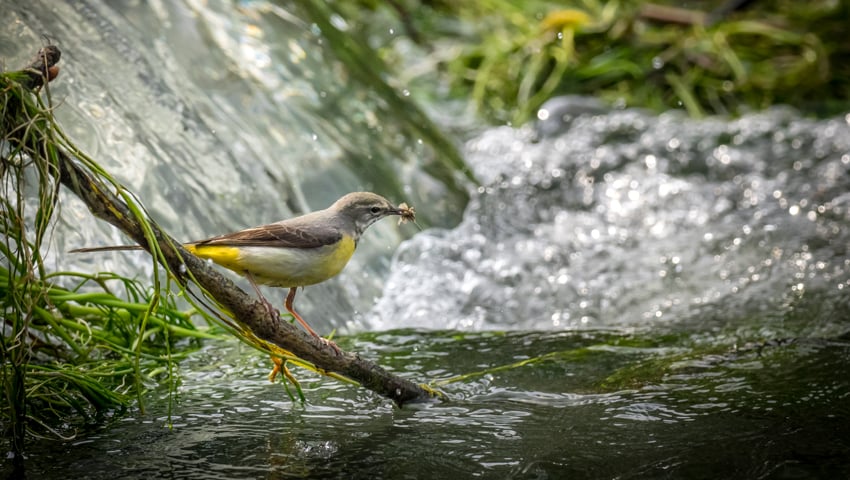A project to revive a stretch of precious chalk stream that inspired poets and painters has been completed, marking the culmination of six-years of work led by the National Trust.
Approximately ten kilometres of the Upper Bure in Norfolk have been carefully restored in a bid to bring back its gin-clear waters, improve prospects for wildlife, and reconnect people with the river.
The restoration, which started in 2018 in partnership with the Environment Agency and the Norfolk Rivers Trust as part of the conservation charity’s Riverlands programme, involved re-naturalising sections of the river by adding fallen trees and large branches, installing new ponds and wetlands, reducing soil run-off from fields and planting over 22,000 trees.
The Riverlands project was funded by The Environment Agency, the People’s Postcode Trust, Garfield Weston Foundation, and UKRI (UK Research and Innovation). Partners include Norfolk Rivers Trust, Natural England, The Environment Agency, Norfolk Ponds Project and Norfolk Rivers Internal Drainage Board.
Emily Long, Riverlands Project Manager, said, “Before the start of the project, the Bure was inundated by over 70 tonnes of Himalayan Balsam, which stifled the important native plants that this habitat needs to thrive. With the help of our fantastic volunteers, we were able to de-congest the river of invasive plants, allowing it to really breathe.
“This work, together with the other steps we have taken, will give the Bure a whole new lease of life with cleaner water, slower flood peaks and a more diverse environment that provides the best possible conditions for the abundance of species relying on this very special habitat.”
Chalk streams are one of the world’s rarest freshwater habitats, with only 220 known examples, the vast majority of which are in England. Their clear waters spring from underground chalk reservoirs, making them a haven for fish such as brown trout and plants like water crowfoot, which bursts into an abundance of white flowers each spring. For centuries, they have been a magnet for writers, artists and fly-fishers.
Sadly, today, many of these habitats have been affected by pollution, artificial river straightening, and abstraction for drinking water.
This is also the case for Upper Bure – the source of the Norfolk Broads, Britain’s largest protected wetland – which had been heavily modified over the years to provide fertile land for farming, water meadows for grazing and power for milling, and which the Riverlands project has sought to mitigate.
Today, the Bure also flows through the historic estates of Blickling and Felbrigg, both cared for by the National Trust. In recent years, both sites have felt the impacts of a changing climate, with heavier rainfall resulting in more frequent flooding incidents, but also prolonged dry spells causing drought.
To help adapt the river to these increasingly frequent extremes, fallen trees and large branches were used on the Blickling estate to return the over-straightened and widened channel to a more natural course. The wood has helped narrow parts of the river and creates different speeds and directions in the flow, helping to oxygenate the water and clean the gravel and pebbles on the riverbed that provide a nursery ground for juvenile fish and invertebrates, such as dragonfly and mayfly larvae. The wood also helps reduce flood risk by slowing the flow of the river during high rainfall events.
The 22,000 trees planted along the river Bure with the help from community groups and primary school children have improved the habitat, providing ‘corridors’ for wildlife such as owls, woodpeckers and bats alongside the river. The new trees, which include alder, silver birch, hazel and black poplar, were planted thanks to funding from the England Woodland Creation Offer.
Stuart Banks, Trees and Woodland Adviser for the National Trust, said, “We’ve selected the tree species based on predictions of a future climate in Norfolk. It’s getting warmer and drier in the East of England, and climate modelling software has enabled us to plan for a woodland that will thrive in changing conditions. As well as providing a habitat for insects, birds and mammals, these woodlands will help store water, keep landscapes and the river cool, clean the air, and sequester carbon.”
The Trust also worked with Norfolk Ponds Project and neighbouring landowners to restore and create 69 ponds and wetlands on areas of farmland, providing new freshwater environments. Further north on the Trust’s Felbrigg Estate, a series of ponds and scrapes were created alongside the river, and a section of riverbed was raised to benefit wading birds, dragonflies, damselflies and water voles.
As well as the benefits to nature, this project has also helped enable physical access to 6km of the River Bure and its tributaries by improving existing and creating new paths.
A further £250,000 grant from the National Heritage Lottery Fund (NHLF) Species Survival Fund this year will also mean the charity can continue restoration efforts on the Bure.
Emily Long said, “As we celebrate the success of the last six years, we are also excited to look forward to the next, and what more we can do to improve this precious chalk stream. We’ll be focussing on water quality and looking at the stream’s headwaters, working with farmers, and continuing our ambition to create a river and catchment that is healthy, clean and rich in wildlife, and that is loved and cared for by all.”
